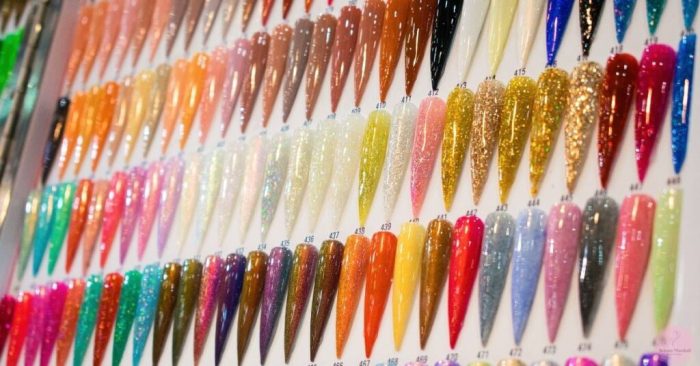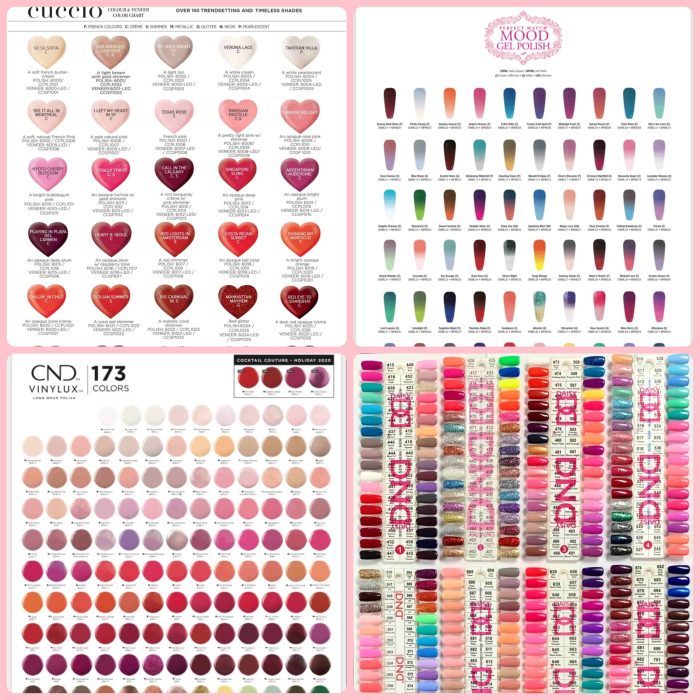Color Wheel Skin Tone Nail Polish Color Matching Chart
Understanding Skin Tone and Nail Polish Color Harmony
Color wheel skin tone nail polish color matching chart – Choosing the right nail polish color can significantly enhance your overall look. This involves understanding the relationship between your skin tone and the color wheel, a fundamental tool in color theory. This section explores the principles of color harmony and how they apply to selecting nail polish shades that complement your unique skin undertone.
Color Wheel Harmony and Skin Tone
The color wheel illustrates the relationships between colors. Complementary colors sit opposite each other (e.g., blue and orange), creating high contrast. Analogous colors are adjacent on the wheel (e.g., blue, blue-green, green), offering a more harmonious and subtle look. Warm skin undertones (yellow or golden hues) generally pair well with warm colors, while cool undertones (pink or blue hues) complement cool colors.
Neutral undertones can often wear a wider range of colors.
Skin Undertone and Color Family Interactions
Warm undertones are flattered by earthy tones, golds, and warm reds. Cool undertones look best with blues, purples, and silver-toned shades. Neutral undertones can experiment with both warm and cool colors, finding balance in the middle.
Complementary Nail Polish Shades by Season and Skin Undertone
Here’s a guide to nail polish shades that typically complement different skin undertones, categorized by the four seasons, a common way to group color palettes.
| Skin Undertone | Complementary Color Family | Example Nail Polish Shades | Suggested Nail Art Styles |
|---|---|---|---|
| Warm | Warm Reds, Oranges, Yellows, Golds | Coral, Peach, Burnt Sienna, Golden Yellow | Floral designs, geometric patterns, ombre |
| Cool | Blues, Purples, Pinks, Silvers | Navy, Lavender, Rose Quartz, Silver Glitter | Abstract art, minimalist designs, metallic accents |
| Neutral | Nudes, Taupes, Browns, Pastels | Beige, Mauve, Light Brown, Mint Green | French manicure, negative space, simple stripes |
Identifying Your Skin Undertone
Accurately determining your skin undertone is crucial for choosing nail polish colors that truly enhance your complexion. This involves understanding the subtle differences between warm, cool, and neutral undertones and employing simple methods to identify your own.
Identifying Warm, Cool, and Neutral Undertones
Warm undertones have a yellowish or golden cast. Cool undertones have a pinkish or bluish cast. Neutral undertones blend elements of both warm and cool, appearing neither distinctly yellow nor pink.
Determining Your Undertone
Several methods can help determine your undertone. Observe the color of your veins (blue suggests cool, green suggests warm). See how your skin reacts to gold and silver jewelry (gold looks better on warm, silver on cool). Check the color of your skin in natural light.
Nail Polish Selection Flowchart
A simple flowchart can guide you through the process. Start by determining your undertone. If warm, choose warm colors. If cool, choose cool colors. If neutral, experiment with both!
Skin Tone Descriptors and Matching Nail Polish Shades
- Ivory: Nude pinks, light peaches
- Beige: Taupes, light browns, muted pinks
- Olive: Deep greens, burgundies, bronze
- Ebony: Deep reds, plums, rich browns, golds
Exploring Nail Polish Color Families
Different color families offer distinct visual effects. Understanding their characteristics and how they interact with various skin tones is essential for making informed choices.
Characteristics of Nail Polish Color Families
Reds range from vibrant to deep and sultry. Pinks offer a spectrum from delicate pastels to bold fuchsias. Blues can be calming or dramatic. Greens provide a refreshing touch. Neutrals offer versatility and elegance.
Each family offers a variety of shades and finishes to explore.
Visual Impact of Different Finishes
Matte finishes create a sophisticated and understated look, while glossy finishes add shine and vibrancy. Shimmer finishes can add a touch of glamour. The impact of these finishes varies depending on the base color and skin tone.
Nail Polish Shades by Color Family and Skin Tone
| Color Family | Warm Undertone | Cool Undertone | Neutral Undertone |
|---|---|---|---|
| Reds | Coral, brick red | Crimson, ruby red | Burgundy, cherry red |
| Pinks | Peach, rose gold | Blush pink, mauve | Dusty rose, pale pink |
Using the Color Wheel for Nail Polish Selection
The color wheel helps identify analogous and complementary colors. Analogous combinations create harmony, while complementary combinations create contrast. Experimenting with both approaches can lead to interesting and stylish nail looks.
Creating a Personalized Nail Polish Matching Chart

Source: britanymarshallbeauty.com
A personalized chart can simplify the process of choosing nail polish colors that complement your skin tone. This involves carefully selecting colors, organizing them effectively, and considering the visual impact of different combinations.
Designing a User-Friendly Chart
A visually appealing chart could be created using a simple color swatch system, where each swatch represents a nail polish shade. The chart could be organized by skin undertone, color family, or occasion.
Illustrative Examples of Nail Polish Combinations
- Warm undertone: Peachy pink with a gold shimmer.
- Cool undertone: Deep blue with silver glitter.
- Neutral undertone: Nude beige with a subtle shimmer.
Visual Effects of Color Combinations
High contrast combinations (complementary colors) can create a bold and dramatic look. Harmonious combinations (analogous colors) create a softer and more subtle effect. The overall effect depends on the specific colors and the individual’s skin tone.
Advanced Techniques and Considerations: Color Wheel Skin Tone Nail Polish Color Matching Chart

Source: beautywithfam.com
Several factors beyond skin tone influence nail polish selection. Considering these elements can elevate your nail art game and help you achieve the desired look.
Impact of Lighting and Personal Preferences

Source: tqn.com
Lighting conditions significantly impact how nail polish colors appear. Natural light provides the most accurate representation. Personal preferences play a crucial role, as the most flattering color is ultimately the one you feel most confident wearing.
Understanding a color wheel skin tone nail polish color matching chart is key to choosing flattering shades. For instance, if you’re considering a warm, sunny hue, you might explore options like a cheerful butter yellow; a great example is the vibrant shade offered by butter yellow nail polish. Returning to the color wheel, remember that understanding your undertones helps you select colors that complement your complexion and enhance your overall look.
Influence of Clothing and Accessories
The overall aesthetic impact of nail polish color choices is enhanced when coordinated with clothing and accessories. Consider the color palette of your outfit when choosing your nail polish.
Challenges and Solutions in Nail Polish Matching, Color wheel skin tone nail polish color matching chart
Finding the perfect match can be challenging. Experimentation is key. Start with small changes, and don’t be afraid to try different shades and finishes.
Resources for Nail Polish Color Matching Inspiration
- Online color palettes and guides
- Fashion magazines and blogs
- Nail art tutorials and inspiration websites
Key Questions Answered
Can I use this chart for both natural nails and artificial nails?
Yes, the principles of color matching apply to both natural and artificial nails. The chart helps you select colors that complement your skin tone regardless of the nail type.
How often should I update my nail polish color choices?
There’s no set timeframe. Update your colors based on seasonal changes, fashion trends, or simply when you feel like a change!
What if I have a skin tone that doesn’t perfectly fit into the warm, cool, or neutral categories?
Many skin tones fall between categories. Use the chart as a guide and experiment to find shades that you feel look best on you.
Where can I find high-quality nail polishes?
Many reputable brands offer a wide range of colors and finishes. Consider reading reviews and checking ingredient lists to find products that suit your needs and preferences.
















